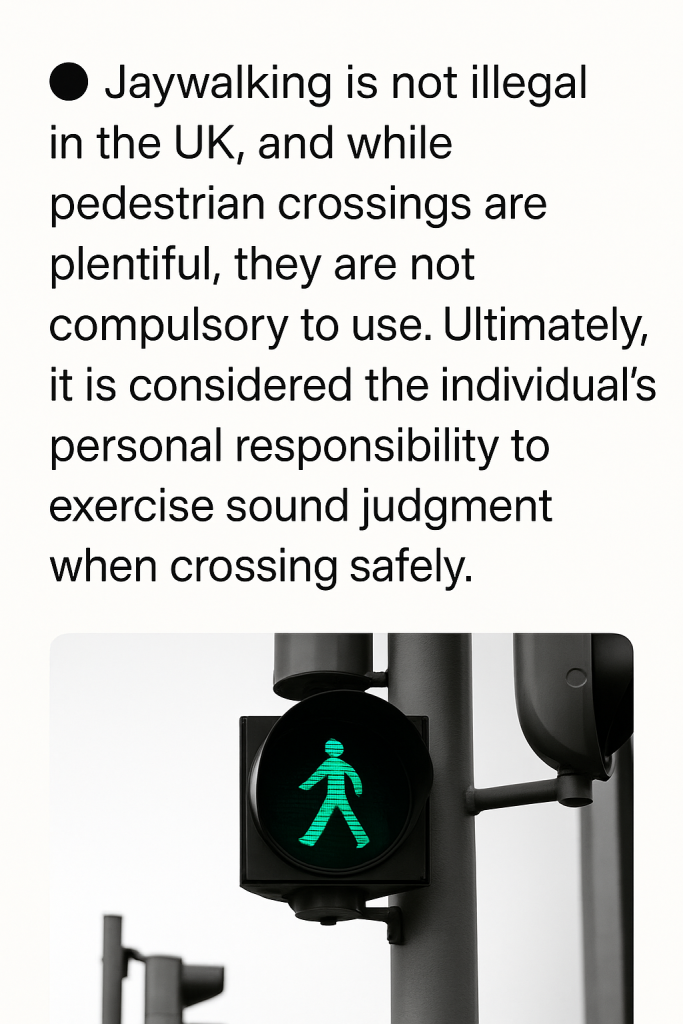In the UK, the idea of jaywalking—crossing the street outside designated crossings—is often misunderstood. Unlike in some countries where it is strictly illegal, the latest guidance in 2024 clarifies that, for most parts of the UK, pedestrians are legally allowed to cross roads at any convenient point, provided it is safe to do so.
This flexible approach to pedestrian road-crossing has prompted renewed discussion as safety concerns remain paramount. Here is what the current regulations and law enforcement policies mean for pedestrians and drivers across the nation.
Understanding the Legal Framework
In Great Britain, there is no specific law that makes jaywalking illegal. Pedestrians are not legally required to use designated crossings such as zebra crossings, pelican crossings, or pedestrian lights when crossing roads in most locations. The key principle is safety: as long as a pedestrian chooses a safe moment and place to cross, their crossing is legal.
However, exceptions apply on motorways and dual carriageways where physical barriers or central reservations exist. In these cases, pedestrians must use designated crossing points and cannot simply cross at any point because these roads are designed for high-speed traffic and are unsafe for unauthorized crossings.
Police Authority and Safety Enforcement
While jaywalking itself is not an offence, police officers retain the right to intervene if a pedestrian’s crossing behaviour causes a danger to themselves or to others. This means that if someone crosses the road in a way that puts themselves or drivers at significant risk—for example, darting out between fast-moving vehicles—the police can step in to prevent harm and promote safety.
Enforcement tends to be focused more on education and warnings rather than penalties. The emphasis is on promoting responsible crossing habits to reduce accidents.
Why No Strict Jaywalking Laws?
The UK’s road system and pedestrian infrastructure differ from places with stringent jaywalking laws. British road design often incorporates ample pedestrian crossings and traffic-calming measures. Authorities balance pedestrian freedom with responsibility, trusting individuals to make safe crossing decisions, except where road design and speed make exceptions necessary.
This approach reflects the belief that pedestrians are responsible for assessing risk, but also benefits those who may need to cross the road between designated points due to urban layout or accessibility needs.
Public Awareness and Safety Tips
Despite the legality, pedestrian safety groups stress the importance of using crossings where possible. Crossings are designed to alert drivers and provide safer conditions for pedestrians. Choosing to cross at unexpected points can confuse drivers, potentially leading to accidents.
- Always look both ways before crossing
- Make eye contact with drivers where possible
- Avoid crossing between parked cars or sharp bends
- Use pedestrian crossings on motorways and dual carriageways
Ultimately, while the UK’s flexible rules offer pedestrians freedom, they come with a need for heightened vigilance and personal responsibility.
Conclusion
As of 2024, jaywalking remains legal in the UK except in designated high-speed road areas with barriers. Pedestrians can cross wherever it is safe, reflecting a trust in individual judgment balanced with common-sense safety and legal exceptions. Police intervention is reserved for situations where dangerous behaviour endangers lives.
Understanding these nuances helps both pedestrians and drivers navigate the roads more safely and courteously, fostering a safer shared environment as we move forward.



